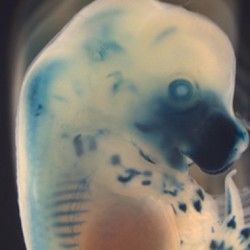 Vahan speaks about Stanford, sticklebacks and skeletal diseases
Vahan speaks about Stanford, sticklebacks and skeletal diseases
Dr Vahan Indjeian joins the CSC’s Epigenetics Section and heads the Evolution of Gene Regulation Group. He joins us from Professor David Kingsley’s group at Stanford University, where he spent the last seven years examining skeletal evolution within various vertebrate systems.
Vahan began exploring stickleback evolution by comparing the skeletal traits of freshwater sticklebacks with the ancestral marine form. Differences between the two stemmed from the melting of the glaciers around 10,000 years ago, when thousands of streams and lakes all over the Northern Hemisphere became home to invading marine sticklebacks. As the sticklebacks adapted to their environments, so too did their body armour, physiology and behaviour, presenting a unique opportunity to study evolution in parallel. “This system allows us to generate thousands of offspring and fine map these traits down to individual genes,” explains Vahan. “The great thing about mapping studies with sticklebacks is that you start with a blank canvas and implement an unbiased genome-wide screen to find the genes involved,” he adds. At the CSC, Vahan is particularly keen to explore early developmental traits within sticklebacks and their behavioural characteristics too.
While at Stanford, Vahan also began questioning what makes us human, and set out to identify regions in the human genome that differ between us and other primates. “There are regulatory elements (switches that turn on or off gene expression) conserved between chimpanzees and other vertebrates such as mice and rhesus, but missing in humans. Investigating these can help explain the genetic basis of the dramatic differences we see between us and our closest primate relatives,” explains Vahan. “What’s more, pinpointing specific genes and regulatory elements that control evolutionary change can also be used to probe skeletal diseases,” he adds. Vahan is particularly interested in identifying the role of key skeletal developmental genes, such as Gdf6 and Runx2, in bone pathology.
To investigate the regulatory elements that surround chimpanzee and human skeletal developmental genes, Vahan links them to a reporter gene called lacZ, before injecting them into murine egg cells. “Once the embryo develops, we add a substrate that is converted into a blue product by the LacZ enzyme, so we can visualize whether the reporter gene has been switched on and expressed, and it’s location.” His ultimate goal is to obtain a blueprint of how the human skeleton develops, with the aim to help identify novel targets for therapeutic intervention in skeleton disease.
Vahan is also keen to pursue collaborative research projects within the CSC. “I have this incredible opportunity to collaborate with some really great groups here at the CSC, which I hope will lead to some fantastic projects and discoveries,” he says.
YJ
